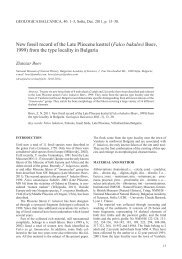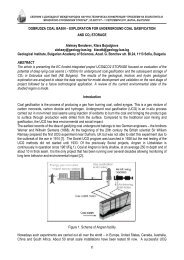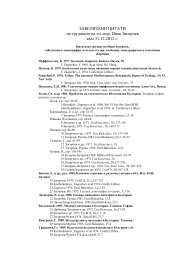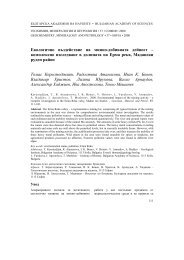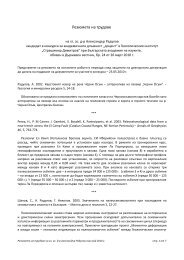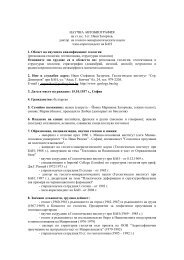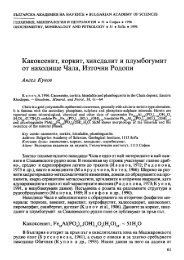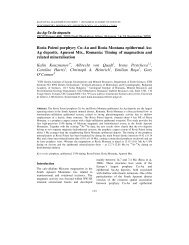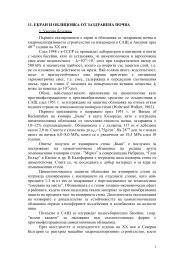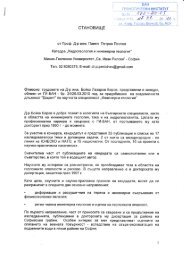Deinotherium thraceiensis sp. nov. from the Miocene near Ezerovo ...
Deinotherium thraceiensis sp. nov. from the Miocene near Ezerovo ...
Deinotherium thraceiensis sp. nov. from the Miocene near Ezerovo ...
You also want an ePaper? Increase the reach of your titles
YUMPU automatically turns print PDFs into web optimized ePapers that Google loves.
Nikolov and Dimitar Kovachev were fully aware of<br />
<strong>the</strong> importance of this very rare case of finding a<br />
whole skeleton of such a huge extinct animal, and<br />
<strong>the</strong>y estimated it to be a representative of a new <strong>sp</strong>ecies<br />
of genus <strong>Deino<strong>the</strong>rium</strong>. Ivan Nikolov, well-known<br />
for his thoroughness, wanted to make an exemplary<br />
publication but his early death stopped for a long<br />
time <strong>the</strong> work on it. The results of his enormous labour<br />
put into <strong>the</strong> description of <strong>the</strong> bones, <strong>the</strong> restoration<br />
and mounting of this unique skeleton, remained<br />
in <strong>the</strong> archives of <strong>the</strong> Geological Institute.<br />
After <strong>the</strong> sudden untimely death of Nikolov in 1984,<br />
<strong>the</strong> work on <strong>the</strong> publication remained unfinished.<br />
Now, D. Kovachev decided to prepare <strong>the</strong> materials<br />
for publication with <strong>the</strong> clear idea about <strong>the</strong> re<strong>sp</strong>onsibility<br />
undertaken, and that <strong>the</strong> whole blame for eventual<br />
flaws and errors should be addressed to himself.<br />
Such publication would be of importance for <strong>the</strong><br />
future studies on genus <strong>Deino<strong>the</strong>rium</strong>.<br />
Many scientists have helped <strong>the</strong> authors in different<br />
time. Prof. Dr. R. Dehm (Director of Universität-Institut<br />
für Paläontologie und historische Geologie<br />
– München) and Prof. Dr. H. Tobien (Director<br />
of Paläontologisches Institut der Johanes-Gutenberg<br />
Universität – Meinz) helped I. Nikolov during <strong>the</strong><br />
first studies and restoration. Academician T. Nikolov<br />
(Geological Institute, Bulgarian Academy of Sciences)<br />
gave valuable advice with <strong>the</strong> material. D. Kovachev<br />
wishes to express his gratitude to Dr. Marin<br />
Iva<strong>nov</strong> <strong>from</strong> <strong>the</strong> Sofia University for his re<strong>sp</strong>onsiveness<br />
to <strong>the</strong> problems of this research. Dr. N. Spassov<br />
(National Natural History Museum, Sofia) kindly<br />
helped with <strong>the</strong> literature I. Nikolov had used at <strong>the</strong><br />
library of <strong>the</strong> Museum.<br />
Studies on <strong>the</strong> genus <strong>Deino<strong>the</strong>rium</strong> –<br />
a historical review<br />
As early as <strong>the</strong> 17 century a place <strong>near</strong> Lyon, France,<br />
was known as “<strong>the</strong> field of <strong>the</strong> giants” because of <strong>the</strong><br />
large animal bones often found <strong>the</strong>re. Some of those<br />
bones came to Matsorier – a surgeon, who used to<br />
show <strong>the</strong>m for years in France and Germany as <strong>the</strong><br />
bones of king Töteboch. Much later, <strong>the</strong> real tomb of<br />
<strong>the</strong> king was found, and <strong>the</strong> deceit was exposed. The<br />
huge bones were transferred to <strong>the</strong> Natural History<br />
Museum in Paris. Probably <strong>the</strong>se are <strong>the</strong> first <strong>Deino<strong>the</strong>rium</strong><br />
remains found.<br />
One century later, in 1715, Réaumure admitted<br />
he could not refer <strong>the</strong> bones to any known animal.<br />
Kenedy supposed in 1775 that <strong>the</strong> materials were related<br />
to mammoths. G. Cuvier thought in 1779—1836<br />
that <strong>the</strong> animal had been a large tapir coexisting with<br />
mastodons. He called it Tapir gigantesque and<br />
thought that its tusks were curved upwards.<br />
Kaup created in 1829 <strong>the</strong> genus <strong>Deino<strong>the</strong>rium</strong> with<br />
<strong>the</strong> <strong>sp</strong>ecies D. giganteum upon <strong>the</strong> skull and mandible<br />
found <strong>near</strong> Eppelsheim, Germany. He thought<br />
this was an intermediary form between <strong>the</strong> sloth and<br />
<strong>the</strong> mastodons and referred <strong>the</strong>m to <strong>the</strong> larger taxonomic<br />
unit Curtognati. In 1841 and 1857 he de-<br />
6<br />
scribed fur<strong>the</strong>r remains of that genus found <strong>near</strong><br />
Eppelsheim and Westhofen. According to him, <strong>the</strong><br />
adult animals had five teeth in <strong>the</strong>ir upper and lower<br />
jaws. In 1833 he described <strong>the</strong> new <strong>sp</strong>ecies D. cuvieri,<br />
but because it was often found in Bavaria, H. v.<br />
Meyer called it D. bavaricum. This name is still used<br />
today. However, arguments about <strong>the</strong> exact place and<br />
<strong>the</strong> life environment of deino<strong>the</strong>res still continued.<br />
P. Gervais accepted in 1848 <strong>the</strong> opinion of Kenedy<br />
and Koch that <strong>the</strong> genera <strong>Deino<strong>the</strong>rium</strong> and Mastodon<br />
should be referred to Proboscidea. He recognized<br />
<strong>the</strong> existence of three <strong>sp</strong>ecies: D. giganteum Kaup =<br />
Tapir gigantesque Cuvier; D. intermedium and D. cuvieri<br />
Kaup. S. Pictet reported in 1853 about <strong>the</strong> finding<br />
<strong>near</strong> <strong>the</strong> village of Absdorf of a whole skeleton of D.<br />
giganteum Kaup. Only <strong>the</strong> head, <strong>the</strong> first two vertebrae,<br />
<strong>the</strong> corpus of a thoracic and a caudal vertebra and<br />
fragments of <strong>the</strong> limbs were preserved. These remains<br />
showed that it is close to <strong>the</strong> mastodon and belongs to<br />
Pachydermae. Four deino<strong>the</strong>re <strong>sp</strong>ecies were recognized<br />
in 1858—1859 by M. Lartet, and namely, <strong>Deino<strong>the</strong>rium</strong><br />
bavaricum H. v. Meyer, D. giganteum Kaup, D. <strong>sp</strong>. (an<br />
intermediary form between <strong>the</strong> first two), and D. cuvieri<br />
Kaup. The first <strong>sp</strong>ecies is known <strong>from</strong> <strong>the</strong> <strong>Miocene</strong><br />
of France and Bavaria, <strong>the</strong> second <strong>from</strong> <strong>the</strong> Late<br />
<strong>Miocene</strong> of France, Germany and Greece, <strong>the</strong> third<br />
and fourth <strong>from</strong> <strong>the</strong> <strong>Miocene</strong> of France. After Lartet,<br />
<strong>the</strong> dental formula of genus <strong>Deino<strong>the</strong>rium</strong> is: I 0-0/1-1;<br />
Pm 2-2/2-2 and M 3-3/3-3 for <strong>the</strong> permanent teeth,<br />
and for <strong>the</strong> deciduous – I 0-0/1-1; deciduous molars<br />
3-3/3-3. New fossil finds in Greece (Pikermi), India (Siwalik),<br />
Europe (France, Switzerland, Austria), etc. have<br />
been reported during <strong>the</strong> last quarter of <strong>the</strong> 19 th century<br />
by A. Gaudry, H. Hensel, B. A. Lydekker, E. Chantre,<br />
M. Vacek, V. Biber, C. Deperet, and o<strong>the</strong>r authors. Gr.<br />
Stefanescu first reported in 1891, and <strong>the</strong>n described<br />
(1895–1910) a deino<strong>the</strong>re skeleton found <strong>near</strong> Manzati,<br />
Romania. Because of <strong>the</strong> large dimensions of all<br />
its bones and teeth, he named it D. gigantissimum. Ehik<br />
(1930) published upper and lower molars and some<br />
finger bones, found in <strong>the</strong> Pliocene sediments of Hungary,<br />
as a new <strong>sp</strong>ecies – Prodino<strong>the</strong>rium hungaricum.<br />
Osborn (1936) changed <strong>the</strong> name of <strong>the</strong> genus (<strong>the</strong><br />
Latinized form Dino<strong>the</strong>rium) to <strong>the</strong> ancient Greek<br />
form <strong>Deino<strong>the</strong>rium</strong>. He revised all <strong>the</strong>n known<br />
deino<strong>the</strong>re materials, discussing in details each <strong>sp</strong>ecies,<br />
and illustrating skulls/mandibles and teeth <strong>from</strong><br />
D. giganteum Kaup, D. bavaricum H. v. Meyer, D.<br />
cuvieri Kaup, D. pentapotamiae Lydekker, D. indicum<br />
Falconer, etc. (Fig. 1).<br />
Numerous new finds of deino<strong>the</strong>res have been reported<br />
during <strong>the</strong> whole 20 th century <strong>from</strong> Austria,<br />
Bohemia, Bulgaria, France, Germany, Greece, Hungary,<br />
Macedonia, Moldova, Pakistan, Romania, Russia,<br />
Serbia, Ukraina, etc.<br />
Studies on <strong>the</strong> genus <strong>Deino<strong>the</strong>rium</strong><br />
in Bulgaria<br />
The first <strong>Deino<strong>the</strong>rium</strong> remains in Bulgaria have been<br />
found by G. Bonchev (Áîí÷åâ, 1897) who made ex-



